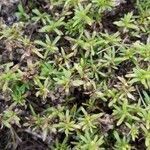Annual herbs. Stems prostrate or ascending, 1-30 cm, puberulent, hairs in 2 rows. Leaves linear to narrowly oblanceolate, 10-30 × 1.5-7 mm, abaxially densely pubescent and dotted with conspicuous orbicular oil glands, adaxially glabrous, margin with conspicuous, spreading basal cilia or bristles ca. 1-3 mm. Inflorescences of solitary terminal capitula or capitula in groups of 2 or 3; peduncles 1-2 mm, bracteolate. Capitula radiate, heterogamous; involucre campanulate to cylindric, appearing almost urceolate; phyllaries 5 or 6, uniseriate, oblong to obovate, 5-7 × 1-3 mm, glabrous, apex truncate. Ray florets 5, female; ray limb bright yellow, 3.5-4 mm, scarcely exceeding involucre, apex scarcely shortly lobed. Disk florets 6-15 (but reported as 10-18 in Taiwan), bisexual; corolla yellow, ca. 2.5 mm. Achenes fusiform, 3-3.7 mm; body weakly many ribbed, sparsely to densely setuliferous; pappus of 3-5 stout, whitish, lanceolate scales 1.5-2.5 mm with margin laciniate. Fl. probably year-round. 2n = 24 (from Mexican material).
Annuals, 1–30 cm (across); herbage not scented. Stems prostrate to ascending (often mat-forming, densely leafy, especially distally), puberulent (in lines or throughout). Leaves linear to narrowly oblanceolate, 10–40 × 1.5–7 mm, margins with 4–12 pairs of setae 1–3 mm, faces glabrous (abaxial densely dotted with round oil-glands 0.1–0.3 mm). Heads borne singly or in congested, (leafy) cymiform arrays. Peduncles 1–2 mm. Involucres campanulate, cylindric, or ellipsoid. Phyllaries coherent (falling together), oblong to obovate, 5–8 × 1–3 mm (often dotted in submarginal rows and sometimes along midribs with elliptic oil-glands 0.1–0.3 mm). Ray florets 5; corollas 2.5–3.5 mm (scarcely surpassing phyllaries). Disc florets 3–17; corollas 1.8–2.5 mm (2-lipped). Cypselae 2.5–4.5 mm, strigillose; pappi of 2 (ray) or 5 (disc) lanceolate scales 1.5–2.5 mm. 2n = 24.

